Hydrogen Fuels Transition to Low-Carbon Fleets
The most abundant element on the planet, hydrogen has long offered promise as a low-carbon energy resource.
Hydrogen is storable and energy dense, providing a fuel source capable of powering medium- and heavy-duty vehicles over long distances.
When hydrogen is produced using renewable energy, it also offers potential as a zero-emission technology. Fuel-cell electric vehicles (FCEVs) convert hydrogen and oxygen into electricity, releasing water vapor as the only byproduct.
As fleet operators consider a hydrogen-powered future, infrastructure considerations include the fueling capacity necessary as more FCEVs are added to the fleet, the impact of refueling stations on operational costs and maintenance procedures, and the overall environmental goals of the fleet-electrification transition.
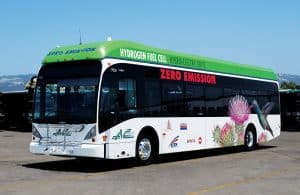
Photo courtesy of National Renewable Energy Laboratory
Falling Technology Costs, Greater Hydrogen Supplies
Over time, decreasing costs coupled with advances in hydrogen-distribution networks may soon contribute to an acceleration in FCEV adoption.
Relatively few fuel-cell electric buses (FCEBs) are in operation today. Yet an increasing number of transit agencies, airports, and private fleet operators are selecting FCEBs as their zero-emission bus of choice due to longer operating ranges compared with battery-electric buses (BEBs). Demonstration projects include:
- Alameda-Contra Costa (AC) Transit District (20 buses)
- Stark Area Regional Transit Authority (SARTA) (19 vehicles)
- SunLine Transit Agency (16 buses)
- Memphis International Airport (15 aircraft tugs)
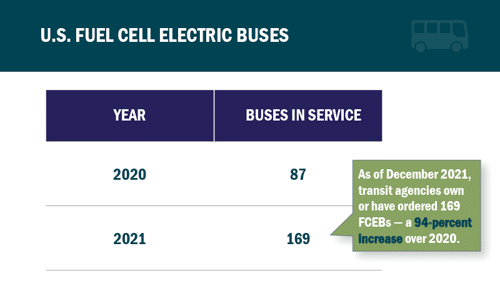
In total, FCEBs are less than 5 percent of all zero-emission buses in the United States. California accounts for the largest concentration of FCEBs in service and the source of most new vehicle orders.
Transit agencies have mostly preferred BEBs due to a lower cost of ownership. When operational and maintenance cost savings are added in, FCEBs still have the highest life-cycle cost among vehicle options.
As of today, FCEBs may prove economical for transit agencies or coach operators that require operating ranges of 250 miles or more. BEBs typically operate with a 150–180-mile range, making them most practical for transit agencies operating shorter-length routes.
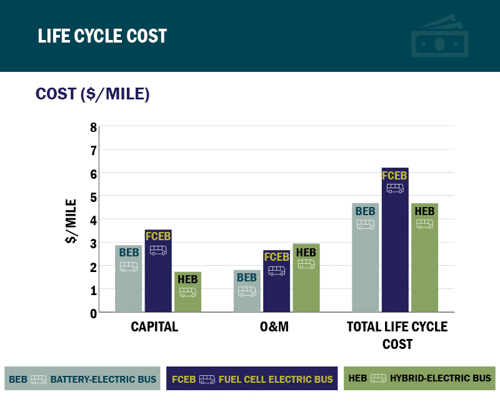
Transit agencies may need to diversify their fleets based on the ranges necessary for each service route. BEBs on long routes require large, heavy batteries — with lengthy charging times — or potentially expensive in-route chargers. FCEBs, on the other hand, can typically operate with a 300-mile range.
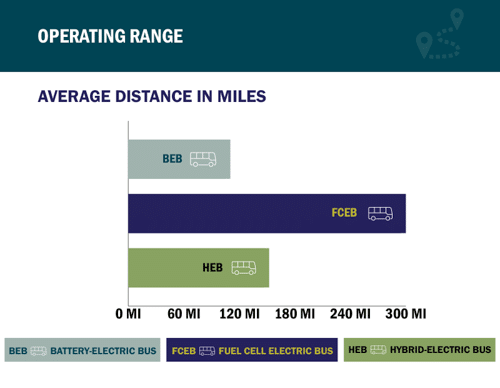
Capital and distribution costs are projected to decline significantly, leading FCEV operating costs to fall by a projected 50 percent in the next decade. Electrolyzer costs are decreasing as well, improving the financial return for on-site hydrogen production.
Meanwhile, utilities and producers are extending hydrogen pipelines and introducing hydrogen into existing gas lines, both of which will reduce hydrogen sourcing costs. In the last year alone, a dozen new hydrogen production, distribution or transmission projects were announced, according to S&P Global
Infrastructure Considerations for Hydrogen Refueling Stations
For fleet owners who already operate Compressed Natural Gas (CNG) facilities, the infrastructure necessary to transition to FCEVs may present less of a hurdle. Similarities include:
- Codes and standards are comparable for handling hydrogen and CNG. Both are Class 2 flammable gases.
- Both types of refueling stations use similar piping, compression, storage, and dispensing systems.
- Maintenance staff must follow similar refueling procedures. Their training and qualifications are applicable across both systems.
For operators building new fueling stations, however, the infrastructure requirements can be significant. Fueling stations require a combination of compression, precooling, dispenser and storage equipment systems.
Hydrogen delivery can account for 40-60 percent of fueling costs — with higher costs for facilities located farther from production sources. With FCEBs consuming, on average, 25 kilograms of hydrogen per day, demonstration fleets often do not use enough fuel to warrant investment in new liquid hydrogen storage or on-site production systems.
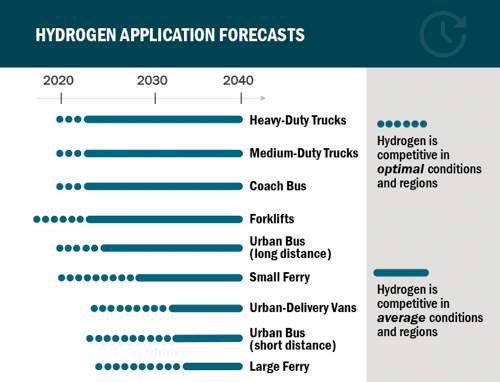
Instead, compressed hydrogen gas supplies are typically transported by trucks in tube trailers. A smaller number of stations rely on liquid hydrogen gas transported by tanker trucks. So far, only a single hydrogen station in Los Angeles is connected to an industrial hydrogen pipeline.
Fueling station design also involves careful considerations of facility ventilation requirements and safety systems. When released into the air, hydrogen becomes a flammable gas at concentrations as low as 4 percent. Required safety upgrades include:
- Dispensers that monitor the fueling process in real time, with built-in leak detectors that can shut off the fueling process in the event of anomalies.
- Gas-detection systems that monitor for any hydrogen storage leaks throughout the facility.
- Ventilation systems that direct hydrogen removed during defueling processes into a storage tank or outside the facility — as far away from any potential ignition sources as possible.
- Electrical system modifications that relocate potential ignition sources.
Hydrogen Comes in Shades of Grey, Blue and Green
Hydrogen can be produced using multiple processes and energy sources. The following colors commonly differentiate current options:
- Grey hydrogen: Relies upon fossil fuels.
A thermal process known as steam-methane reforming is the most common hydrogen-production method, extracting the fuel from high-temperature steam fed by natural gas-produced methane.
- Blue hydrogen: Applies carbon capture and sequestration (CCS) technology.
Options include CCS combined with steam-methane reforming or waste gas purification, a process that separates hydrogen from natural gas or coal gasification.
- Green hydrogen: Emits zero emissions.
Water electrolysis fueled by renewable electricity is the most established among technology options. An alternative method, biomass gasification, converts renewable biomass through chemical reactions.
Developing cost-competitive green hydrogen will depend on future electrolyzer capital costs, electricity prices, and the electrolyzer’s capacity factor. With up to 1 MW of electricity needed to fuel a dozen FCEBs, electrolyzer costs will need to fall significantly for green and grey hydrogen to reach cost parity in most markets.
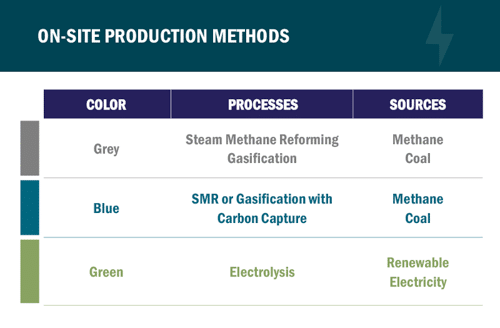
The prospect of continued decline in costs for renewable energy and battery technology has led many transit agencies to explore innovative approaches to green hydrogen production.
Where electricity prices are high and open space is abundant, transit agencies can partner with solar project developers to build and own their own solar arrays, using the electricity to offset hydrogen production costs. An alternative approach involves leasing the land to a solar developer, then procuring the electricity on a long-term deal that would cover hydrogen production costs.
Hybrid configurations can be deployed to lower green hydrogen costs. Some facilities have combined liquid hydrogen with electrolysis to meet a portion of demand. Other strategies use distributed energy resources to supplement grid electricity, dispatching electricity from on-site storage systems at times when electricity prices are greatest.
Hydrogen Is No Laughing Matter
Hydrogen offers exciting potential, especially for bus operators with long-distance routes.
As capital and operating costs decline in the years ahead, hydrogen’s value proposition will likely improve. Growing fleets will benefit from existing refueling infrastructure, with the incremental cost of fleet expansion potentially limited simply to the price of new buses.
As FCEV fleets scale up, on-site hydrogen production may become more economical, especially as distributed energy resources get cheaper to own and operate. By controlling the production process, fleet operators can control the environmental impact, influencing whether FCEVs are truly “zero-emission” vehicles.
Energy observers have a longstanding joke about hydrogen: “It’s the fuel of the future — and it always will be.” Though widespread adoption of FCEVs remains several years away, the hydrogen future is now closer than ever before.


